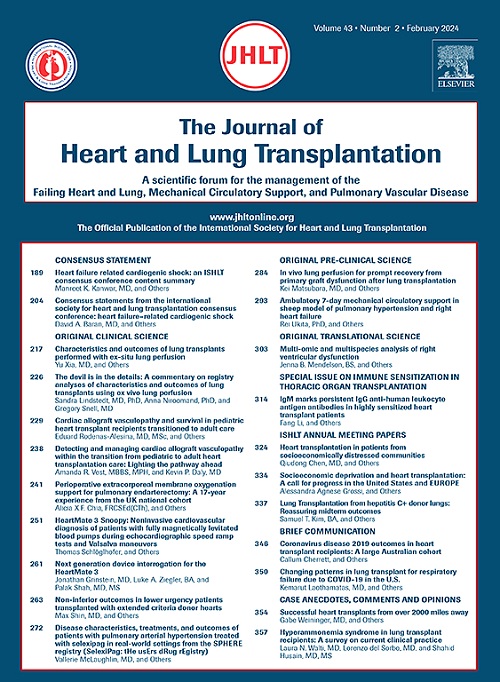Pediatric heart transplantation within the Scandiatransplant region—a multinational observational study spanning 38 years
IF 6
1区 医学
Q1 CARDIAC & CARDIOVASCULAR SYSTEMS
引用次数: 0
Abstract
Background
Thirty-eight years of pediatric heart transplantation (pHTx) within the Scandiatransplant organization were analyzed to describe volume trends, regional prevalence, underlying etiologies, and outcomes following listing and pHTx.
Methods
Children <18 years listed for pHTx from January 1st 1986 to December 31st 2023 were identified in the Scandiatransplant registry. The cohort was split into groups based on the era of listing (ERA I; 1986-1998, ERA II; 1999-2011, and ERA III; 2012-2023).
Results
A total of 597 children were listed and 461 (77.2%) reached pHTx. The regional incidence of pHTx was 4.0 per 100,000 live births. All centers performed a median of <4 pHTx per year. 6.5% were transplanted at <1 year of age. Waiting list duration increased over time, withdrawal frequency remained stable, and listing mortality decreased from 22.8% in ERA I to 6.8% in ERA III. The distribution of listing and transplant diagnoses were not different between eras. ABO-incompatible transplants increased over time, from 1.0% in ERA I to 8.8% in ERA III, as did transplant from ventricular assist devices (6.6% in ERA I, 19.9% in ERA III). Post-transplant survival was 78.0% at 10 years and 51.4% at 30 years. Survival was worse in patients with an etiology of congenital heart disease compared with cardiomyopathies. Era of listing was a determinant of listing mortality but not of post-transplant survival.
Conclusions
Numbers of pHTx in the Scandiatransplant region are low but have increased with time. There has been a significant decrease in waiting list mortality over time, whereas improvements in post-pHTx outcomes have been less evident, most likely due to excellent short-term outcomes for the first graft recipients in the region.
加拿大移植地区的儿童心脏移植——一项跨越38年的多国观察性研究。
背景:对Scandiatransplant组织内38年的儿童心脏移植(pHTx)进行了分析,以描述列出和pHTx后的数量趋势、地区患病率、潜在病因和结果。方法:从1986年至2023年12月31日在加拿大移植登记处找到儿童。该队列根据上市时代(era I;1986 - 1998,第二阶段;1999 - 2011年,ERA III;2012 - 2023年)。结果:共纳入597例患儿,461例(77.2%)达到pHTx。pHTx的区域发病率为每10万活产4.0例。结论:在scandiattransplantation区域pHTx的数量很低,但随着时间的推移而增加。随着时间的推移,等待名单上的死亡率显著下降,而phtx后结果的改善则不太明显,这很可能是由于该地区第一批移植受体的短期效果很好。
本文章由计算机程序翻译,如有差异,请以英文原文为准。
求助全文
约1分钟内获得全文
求助全文
来源期刊
CiteScore
10.10
自引率
6.70%
发文量
1667
审稿时长
69 days
期刊介绍:
The Journal of Heart and Lung Transplantation, the official publication of the International Society for Heart and Lung Transplantation, brings readers essential scholarly and timely information in the field of cardio-pulmonary transplantation, mechanical and biological support of the failing heart, advanced lung disease (including pulmonary vascular disease) and cell replacement therapy. Importantly, the journal also serves as a medium of communication of pre-clinical sciences in all these rapidly expanding areas.

 求助内容:
求助内容: 应助结果提醒方式:
应助结果提醒方式:


